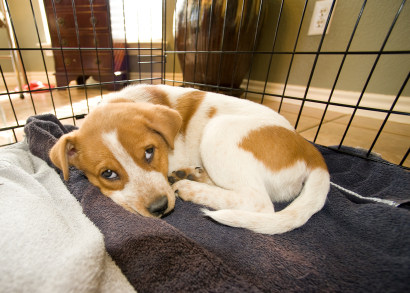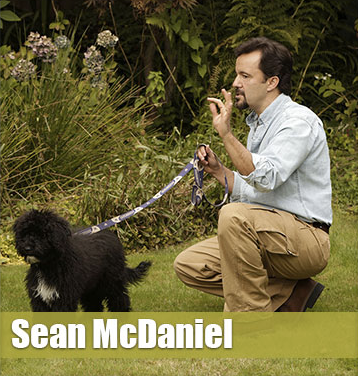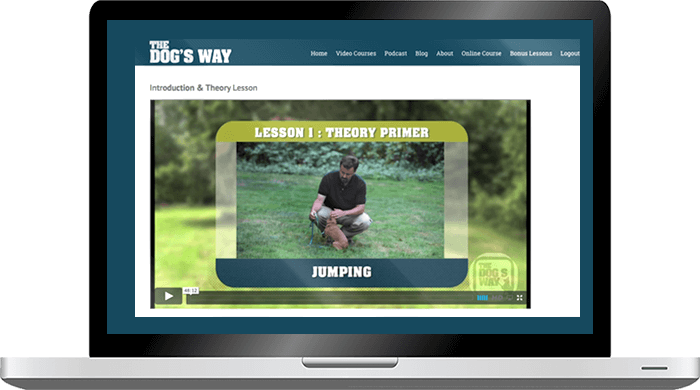House Breaking 101: Pup’s First Few Weeks

Here is a quick primer on house breaking. There’s a sample schedule at the end to give you a framework to follow in your puppy’s daily schedule.
House Breaking Overview
- When starting out in your house breaking plan, your 8-9 week old puppy will not be able to hold their bladder through an entire 8 hour period at night without having to go out once or go out very early in the morning.
- Your 8-11 week old puppy will sleep 15-18 hours of any 24 hour period in various 1-3 hour napping periods throughout the day and 5-7 hours at night.
- Your 8-11 week old puppy will have to go to the bathroom 8-10 times per day (every 2-3 hours)
- It will take 3-6 weeks to follow a schedule so that they understand bathroom rules. (this assumes no accidents –accidents make this period last longer)
- Your puppy will have to relieve themselves every time they awake and within 5 to 20 minutes after eating and drinking.
- Your mantra for puppy house-training will be “schedule, consistency and supervision”. If you can stick with this for the first month and a half, it will pay dividends for years – stick with it!
A big part of house breaking is having a consistent ritual for taking your pup out:
- Always take your puppy out to the same spot during your first month of house breaking
- Always go out the same door to the bathroom area. Ideally, it helps if this is the same door that your puppy will have access to during your supervised times in the house.
- Always go outside with your puppy rather than let them run outside alone to potty.
- As you open the door, while you’re walking them out to the “spot”, repeat the word “outside?” as they follow along with you praise them. You may need to pick them up, and physically move them to the open door in the first few days, if they get distracted for even a second or two.
- After your puppy has been conditioned to a leash, always take them out to potty on leash.
- Once you reach the bathroom area, as they sniff around, begin to repeat the phrase that you’re going to consistently use, that means “go to the bathroom”. (For example: “go potty!”, “Go pee!”, “Do your business!”)
- In your first few weeks of house breaking, be sure to praise them once the puppy relieves herself outside. You can also offer a treat after they’re done. (Be careful though that the praise isn’t so vigorous that it startles your puppy while they’re relieving themselves)
- IMPORTANT HOUSE BREAKING TIP: Stay outside a little longer after they have relieved themselves. It’s not uncommon for a puppy to go to the bathroom a couple of times if they’re outside exploring for more than 10 – 20 minutes.
- PLEASE DON’T (once you’ve conditioned your pup to a leash) carry your puppy out to the bathroom area for regular (non-emergency) trips. If you do all the work in taking them outside by carrying them then they don’t transition to going to the door and walking “outside” themselves.
Body Language: Indications of having to “go”!
When you’re in a house-breaking phase, you have to continually observe your puppy. A puppy may start to sniff in a spot and begin to move away from you. A puppy may start to circle or arch their back prior to going to the bathroom. If a puppy consistently goes back to a spot where there’s previously been an accident then the chemical marker may still be there to “go here!” Re-clean that area with a good enzyme cleaner and don’t allow your puppy to wander over there again until you’re sure it’s been made chemically inert by the cleaner. As your puppy learns, she may start going to the door that leads to the bathroom area when she needs “to go”. (This is why you’re going to the same door during house training process and repeating “outside?” as your verbal cue). If she does go to that door, you can start to ask, “Outside?” repeatedly. If your puppy seems to become more animated then begin the “going outside” ritual. Be aware though that some young puppies give no warning and simply squat right in the middle of playing and pee before you see any signals. This is one of the reasons play time outside is preferred for house-training with very young puppies.Finnlo multi-gym extension best buy at – sport-tiedje weight loss download delavier musculation files pdf – torrent.
Puppy Accidents During House Breaking
If your puppy begins to relieve themselves in the house, catch them right away. Without yelling, make a noise (perhaps a hand clap to startle them), and repeat the command “NO!” firmly several times while you pick the puppy up and quickly take him out to the bathroom area and go through that bathroom ritual outside until they’re done. Clean up the mess with an enzyme cleaner and re-commit to watching your puppy and their body language more closely. If your puppy consistently gives no indication of having to “go”, then you must only have play times outside for a couple of weeks until they gain more control.
Here Are Some “Don’ts”
House breaking is about planning, schedule, and consistency. Ideally, there shouldn’t be accidents if we’re following the rules in this article. However, if an accident does occur, please do not hit the puppy with a rolled up news paper, yell wildly, or rub their nose in the mess. A firm repetitive “NO” should communicate sufficiently that this isn’t something we like.
Inside Time
The cardinal rule of house breaking is – no unsupervised time inside. Make sure that all of your inside time, playing, bonding, and training happens after bathroom breaks. If you see your puppy exhibiting body language that looks remotely like they want to relieve themselves (e.g. focused sniffing, moving away from you, moving to the perimeter, or behind furniture) then start the bathroom ritual and take them out to the bathroom area right away.
Access to Water
You should also have free access to an inside and an outside water bowl while you’re playing. Once your puppy takes a break from playing or training to have a drink of water, it’s time to start the bathroom ritual and take them out to the bathroom area. Note that any inside play time should be limited in the first few weeks to prevent accidents (Also note that any inside water bowls should be fairly heavy to prevent tipping and spilling or the occasional game of dish-hockey) The instructions in the schedule that indicate periodic access to water are only for puppies that have a hard time holding their bladder in the crate for short periods. Restrict all pup’s access to water 60 to 90 minutes before bedtime. This rule also assumes no vigorous play in that last hour before bed either.
Getting Ready for Bed
Do have some outside time that allows lots of sniffing. A large part of a dog’s brain is devoted to scent exploration, and this is a great ‘low physical exertion’ way to tire a dog out. You can also allow some mild play time at the end of the day just prior to the final bathroom break before bed. Please don’t make this vigorous play though as you’re not going to allow water right before bedtime. After this outside evening ritual, bring your pup in, and place them in the crate with an indestructible chew toy and lay a blanket over the crate partially covering the door. Allow enough air exchange to make the crate comfortable.
When your puppy is young, the crate for bedtime ought to be near you so your pup still feels connected to, and protected by you. If it’s possible, placing the crate next to your bed is ideal, in the first couple of months, so you can tell if your new pup needs to go out at night, or is in distress in any way. In the first couple of weeks, some folks find that sleeping in close enough proximity to have your fingers inside the crate door as your pup settles to sleep helps more nervous puppies. I should also preemptively respond to any questions about “spoiling” a puppy by using these suggestions. Any techniques that involve closer proximity to, or physical contact with, your young puppy are used as a transitional technique for a period of time. We want to take into account a puppy’s developmental stages, in a way that we might when raising kids. Certain techniques are helpful and effective at early stages of development and are counter-productive in later stages. More physical contact, and closer proximity with you early on, allows your pup to adapt from the continuous physical contact they grew accustomed to while sleeping with mom and litter mates, to a more independent sleeping arrangement as they grow up.
Notes on Submissive or Greeting Urination
If a puppy has “accidents” only upon greeting people this is not a “house breaking” issue. If you use the “NO!” command and run the puppy out to the bathroom area this will likely only make the greeting urination worse. Most puppies that exhibit this behavior will outgrow it by the 5th month if you make a conscious effort to work them out of it. Please talk to one of our trainers about this behavior as it is behaviorally different that a housebreaking issue.
| SAMPLE DAILY SCHEDULE FOR PUP”S FIRST FEW WEEKS | |
| TIME | ACTIVITY |
| 6:00 am | Take pup out of the crate and go immediately to the bathroom area |
| 6:15 am | Feed puppy breakfast, give water |
| 6:45 am
|
Take pup out for a little walk and do some of your homework, exploring, socializing, and bonding. After (or sometimes during) that homework period take puppy to the bathroom area again. After pup goes to the bathroom, you can have some inside supervised homework, play time, and bonding. (keep in mind that play that is too vigorous may elicit an elimination response from your puppy) If your inside supervised playtime lasts more than 30-60 minutes, take pup back out to go to the bathroom area before putting pup back in their crate for a nap. |
| 7:15 am | Put your pup in their crate for a nap (give pup some indestructible chew toys to have in their crate). |
| 10:30 am | (if your schedule allows) Take pup out to the bathroom and for an exploration and training/bonding session. |
| Noon
|
Take puppy out of the crate directly to the bathroom area. After pup goes to the bathroom, feed puppy lunch and put down water. Take pup out to the bathroom area one more time before spending a little play/work time inside. Confine puppy in the crate before leaving home or moving on to some activity that you can no longer watch the puppy 100% of the time. |
| Mid- afternoon | Take pup out of the crate, and go immediately outside to the bathroom area. Give your pup access to the freely available outside water when playing. Spend some time playing, socializing, bonding and training outside. Give your pup one more ten minute period after playtime to go to the bathroom area,(this means stop actively playing and just ”hang-out” at the bathroom area) then put her back in the crate. |
| Home from work
|
Take pup out of the crate directly to the bathroom area. Feed puppy dinner in their crate. Give your pup access to the freely available water outside, homework, play, socializing, and exercise – one more bathroom area visit before spending supervised time playing in the house. IMPORTANT NOTE: Most puppies have an evening “wild period”. The timing varies slightly from pup to pup but when you figure out your pup’s schedule, plan an extra playtime outside in the late afternoon to early evening just prior to that period. |
| Early evening
|
If you have to prepare dinner/deal with kid’s homework/watch a really important playoff game, where you can’t closely supervise your pup put puppy away in the crate after your extra play time (keep in mind though that ,ideally, for most people’s schedule, this is your prime puppy training/bonding time. Take advantage of that time and be aware that if your pup gets to have a nice long nap at 8 pm, you’re probably not getting them to sleep at a regular time! |
| Mid-late evening | Last play/bonding session before bed. Take pup out to the bathroom area |
| NOTE | NO WATER 60-90 minutes before bedtime. Take the puppy to the bathroom area just before bed. Place them in their crate with a towel partially covering the crate to make it less noisy. Leave room for air flow through the crate door. |
| Bedtime | Put pup in their crate for bedtime with a couple of solid indestructible chew toys to entertain themselves for the first few minutes in the crate. |
THIS IS ONLY A SAMPLE HOUSE BREAKING SCHEDULE AND IS ONLY A FRAMEWORK: This example assumes someone works a day job and can have someone home at lunch and mid-afternoon to see to those items on the schedule. This schedule is intended to be one example and not the definitive schedule that must be adhered to. Please follow the principles and adjust the particulars to your own schedule and your own pup’s needs. For example, in the first 2-3 weeks you may be up earlier than 6 am due to your pup not being able to control their bladder through the entire night. Also, you may have an ideal scenario where you work from home and can spend many more bonding, exercising and play sessions with your pup. Do keep in mind though that young pups sleep more than you think and crate time promotes that needed sleep. Also, it’s good for puppies to gradually learn to be comfortable in a crate, so even in cases where you are around 24/7 with your puppy, do follow some of these crate time schedules.
By the way, here are some other puppy related articles on our blog that you might be interested in:
How to teach your pup to “ask” to go outside
Your Puppy”s First Couple of Weeks: Tips to make the transition easier on you and your pup
Good luck with your new pup!
All the best,
Sean

About the Author: Sean
I’ve been training people and dogs in Seattle for the last decade and a half. My main focus when working with clients every week in one-on-one, private lessons is to help people learn to get their dogs to a functional level so that they can actually enjoy spending time every day with their dog instead of stressing about their dog’s behavior issues.
3 Comments
Leave A Comment
You must be logged in to post a comment.
Affiliate Program
Make money by referring people to the video course!
. . . . .

About Sean
I’ve been training people and dogs in Seattle for the last decade and a half. My main focus when working with clients every week in one-on-one, private lessons is to help people learn to get their dogs to a functional level so that they can actually enjoy spending time every day with their dog instead of stressing about their dog’s behavior issues.
Ask Sean a question!
If we use your question in the show, Sean will send you a coupon code for free access to the online video course!
If you have a question you’d like me to respond to on the show (and you want to hear yourself on a future episode) leave me a voice mail! 1 (844) 364-7929 or email me here.


Great article, thanks for sharing. I’m bringing home a 9 week old puppy in a few weeks and I need all the advice I can get
We are firstvtime parents to a 9 week Boxapoint puppy
He is the sweetest but like all babies we u dersrabd he is teething and these are growing pains for him as well as us
We need help to prevent him for biting and going crazy chewing
He has not had his shit as yet do we aren’t taking him out
Also he hates the leash. Help us
How do I adapt a schedule if it’s cold and rainy and my pup hates being outside?